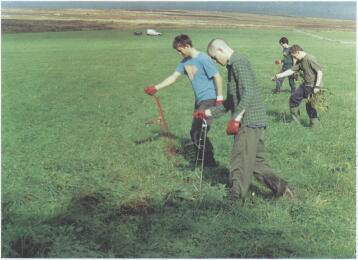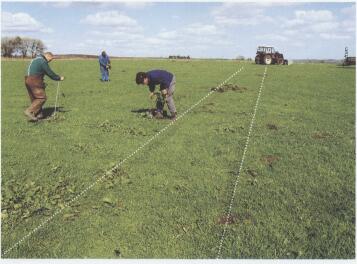Philip Trevelyan and Dr. John Zarb
Article taken from Conservation and Land Management - Volume 2, Number 4 - Winter 2004
Return to Publications Page | Page 1 | Page 2 | Page 3 | Page 4 |
|
Work rate and cost predictor for spear thistle
|
|||||
|
No. Plants
per 25m2
|
No. Plants
Removed per min. |
Man-hours
per ha |
Cost
per ha
(at £7.50 per hour) |
||
|
1-5
|
3-6
|
2.5-5.5
|
£18.75 - £41. 25
|
||
|
5-10
|
6-10
|
5.5-8
|
£41.25 - £60.00
|
||
|
10-20
|
8-12
|
8-14
|
£60.00 - £105.00
|
||
|
20-30
|
10-14
|
14-20
|
£105-£150
|
||
|
30-40
|
10-14
|
20-27
|
£150 - £202
|
||
|
40-50
|
10-14
|
27-33
|
£202 - £247
|
||
In order to
optimise the
efficiency of weeding teams, the
following points should be
noted:
efficiency of weeding teams, the
following points should be
noted:
• manual work groups should
be motivated by the belief that
theirs is the method of choice for
worth and efficiency;
be motivated by the belief that
theirs is the method of choice for
worth and efficiency;
• proper use
of the tools should
enable workers to operate eight
hours a day;
enable workers to operate eight
hours a day;
• operators
should understand the ergonomic advantages of the tools;
• work leaders
should be able to
motivate and interact with
colleagues; and
• a systematic
approach is required for removing and collecting plants.
Limitations
of RIP handwork
No single
sustainable farming or
conservation technique is a
panacea - its value depends on
labour, motivation, land use
conservation technique is a
panacea - its value depends on
labour, motivation, land use
Left Lazy Dog weeding gang
at work.
Philip Trevelyan
• changes to
agricultural tillage
practices, to avoid the vegetative
spread of weeds, such as
creeping thistle, buttercup,
couch grass and dock;
practices, to avoid the vegetative
spread of weeds, such as
creeping thistle, buttercup,
couch grass and dock;
• 'hot composting'
- allowing
the compost to reach;
temperatures of between 60° and
65°C before turning to reactivate
the process in order to destroy
weed seeds;
the compost to reach;
temperatures of between 60° and
65°C before turning to reactivate
the process in order to destroy
weed seeds;
• removing plants
before seed
set - an obvious but neglected
practice;
set - an obvious but neglected
practice;
• choosing drilling
times and
seed rates to enable rapid, early
and full crop cover in order to
achieve weed suppression in
farming situations.
seed rates to enable rapid, early
and full crop cover in order to
achieve weed suppression in
farming situations.
Predicting
work rates
and costs
and costs
In order to
optimise RIP
handwork, work rate and cost
predictors have been developed
from practical experience. These
are based on a combination of
weed density, age and size, and
the expected time and costs of
weed removal for a given species.
These enable weeding jobs to be
accurately planned and costed.
We know from experience,
for example, that spear thistle at
a density of, say, five plants in
5m2 (or 2,000 plants per ha) can
be removed at a rate of around
six plants per minute, or 360 an
hour. It will therefore take
around 5.5 hours to cover lha. A
cost of £60 per day equates to
£7.50 an hour. Five-and-a-half
hours work at £7.50 an hour
costs £41.25 (see table above).
handwork, work rate and cost
predictors have been developed
from practical experience. These
are based on a combination of
weed density, age and size, and
the expected time and costs of
weed removal for a given species.
These enable weeding jobs to be
accurately planned and costed.
We know from experience,
for example, that spear thistle at
a density of, say, five plants in
5m2 (or 2,000 plants per ha) can
be removed at a rate of around
six plants per minute, or 360 an
hour. It will therefore take
around 5.5 hours to cover lha. A
cost of £60 per day equates to
£7.50 an hour. Five-and-a-half
hours work at £7.50 an hour
costs £41.25 (see table above).
Weeding brigades
Nowadays, particularly in
farming, we
are conditioned to
think that only highly
technological approaches are
progressive or efficient, and that
any kind of manual work is a
backward step. Appropriate
technology is the key issue in this
respect. Properly organised,
properly equipped, and properly
motivated handwork teams have
been shown to be highly effective
in weed control.


Left Removing
docks from pasture using tractor wheelings in grass as a marker line
to indicate where to work up to.
Philip Trevelyan